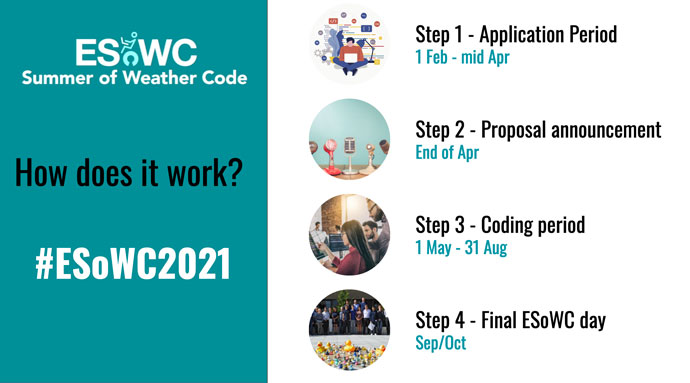ECMWF’s Summer of Weather Code 2021 (ESoWC) will launch its fourth edition on 1 February 2021. Innovative weather, climate and atmosphere-related challenges and ideas that will be highly beneficial to ECMWF and Copernicus activities will be proposed on Github, where interested parties can submit a proposal on how to tackle the challenge.
At the core of ESoWC is the provision of innovative and open-source software solutions as well as attracting external expertise and new talents. The application period will end mid-April and the selected teams for the coding phase will be announced at the beginning of May. ESoWC’s coding phase between May and end of August is an intense and fruitful collaboration among mentors and developers, leading to a mutual learning experience. The coding phase is the highlight of ESoWC. During this time, the initial proposals are implemented into feasible software developments and innovations.
After the coding period, provided that all milestones and deliverables are fulfilled, the developers will receive a stipend of £5,000. The presentation of the final results will be a virtual event, the Final ESoWC Day, to take place in September 2021.

Innovation and high quality in ESoWC 2020
The last edition of ECMWF’s Summer of Weather Code in 2020 included nine open-source projects that once more highlighted the innovative nature of ESoWC. All coding solutions had a high impact; some of them have been earmarked for implementation and further development.
For the first time, ESoWC 2020 was supported by two cloud computing systems, the Copernicus data and information access service WEkEO (https://www.wekeo.eu/) and the European Weather Cloud jointly developed by ECMWF and EUMETSAT (https://www.europeanweather.cloud/). This allowed ESoWC to offer sufficient storage and processing capacities for the compute-intensive projects. The new edition of ESoWC in 2021 will also be supported by both cloud computing systems. ESoWC 2020 projects were at the intersection of machine learning, open-source computing, cloud computing and open data. Four teams explored the use of artificial intelligence in a range of applications:
- DeepGEFF is an example of the application of deep learning techniques to the science of fire prediction. The project compared skills between the Global ECMWF Fire Forecasting (GEFF) system and artificial intelligence. The machine learning-based model increased the wildfire prediction accuracy all over the world.
- The Conversational Virtual Assistant (CVA) is a project that facilitates help desk support to external ECMWF and Copernicus users. This project developed a chatbot that uses natural language processing and machine learning technologies to assist in finding responses to questions on ECMWF products and services.
- A machine learning project addressed the challenge of monitoring point and contextual anomalies within the ECMWF production chain system with the help of artificial intelligence methods and an Anomaly Detection System.
- A deep-learning approach to improve tropical cyclone prediction and tracking has created an algorithm able to recognise and classify tropical cyclones based on their intensities, over four classes.
Three teams put a focus on Copernicus open data:
- To predict the dramatic impact of climate extremes, such as floods, wildfires and thawing permafrost, the project UNSEEN-Open developed a reproducible, open workflow that allows an assessment of natural hazard events globally.
- The classification of air quality project developed a classification scheme to validate and remove outliers from surface air quality observations. This quality control method allowed the comparison of station data with air quality forecasts from the Copernicus Atmosphere Monitoring Service.
- The project DAAQS (Detecting Anomalies in Air Quality Stations) applied machine learning clustering algorithms to classify similar and dissimilar air quality stations to measure their reliability and representativeness scores.
Another two teams worked on challenges related to ECMWF’s model performance, data storage and archiving:
- The Elefridge project explored the potential of compressing atmospheric data while preserving real information to reduce storage and to facilitate data sharing. It provided evidence that the size of climate and weather forecast data archives can be reduced by one to two orders of magnitude without losing valuable information.
- The HPC performance profiling tool project aimed to improve the performance analysis of ECMWF’s Integrated Forecasting System (IFS). The software application is a graphical, extendable and easy-to-use interface that allows the visualisation of HPC performance data metrics tailored by the user.
More information about ECMWF’s Summer of Weather Code can be found at https://esowc.ecmwf.int/ and https://github.com/esowc as well as on Twitter: @esowc_ecmwf.

